Along with amplifiers, record players and TVs, one of the products most closely associated with What Hi-Fi? is stereo speakers.
The idea behind them hasn't changed and is relatively simple – an enclosure, sometimes small, sometimes big, capable of taking a signal fed to it from an amplifier and shooting it out as sound. Ideally with great skill and style.
Most speakers are still wooden boxes, but technology has allowed some manufacturers to sculpt a speaker out of carbon fibre or aluminium. And while they haven't changed much in appearance, inside they've been refined into engineering feats of wonder - technology seems able to constantly find new and better ways of making music sound great.
This lengthy list is a celebration of the speakers that have a special place in our hearts – and yours too, hopefully – as we flick through What Hi-Fi?'s past for the best 30 pairs of speakers to be lifted, wheeled and even crated in to our test rooms.
MORE: How to choose the right speakers
KEF Coda II (1982)

The KEF Coda IIs were budget speakers, designed to be compatible with amplifiers that delivered 10 or more watts per channel, and they offered exceptional value.
Though the Coda IIs' tonal balance was on the brighter side, it leavened that with an open sound and accurate imaging.
Available in two finishes (black or simulated walnut veneer) they looked pretty good, especially when the grilles came off.
MORE: KEF Q350 review
Wharfedale Diamond I (1982)
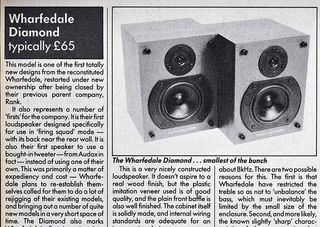
The original Wharfedale Diamonds were pint-sized efforts for those who needed a speaker to fit into a tight space.
They were nicely constructed, with a solidly made cabinet (an enclosure of just over five litres) and a finish that traded real wood for a good quality plastic imitation veneer.
With sophisticated midrange and bass performance for the price, the Diamonds were fussy in terms of partnering kit but excelled with more upmarket amplification.
MORE: That Was Then... Wharfedale Diamond review
Mission 70 Mk II (1983)

By 1983 Mission had updated its '70' speakers and, despite the model number, the 70 Mk IIs were the third iteration.
That gradual process of evolution led to a pair of speakers that had breadth, scope and vividness beyond their peers. And in spite of the speaker's small size, they had the sound of a larger, more expensive unit.
Treated well, the Mission 70 Mk IIs produced an exciting listening experience.
MORE: Mission LX-2 review
Heybrook HB1 (1983)
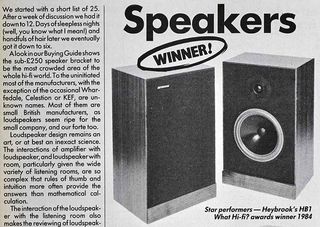
The Heybrook HB1s were a highlight of What Hi-Fi?'s early years, winning multiple awards in the early 80s.
The HB1s were entry-level speakers, and though they worked well with budget equipment they excelled when partnered with top-quality electronics.
With a high-quality finish and dynamic sound, the HB1s were another example of a speaker that could hold its own against much more expensive efforts.
Acoustic Energy AE1 (1988)

Acoustic Energy's AE1 were on the smaller side, but let them rip and they were capable of impressive punch and dynamic reach.
They featured metal drivers - rare for the time - and the internal cabinet walls were plaster-coated to minimise the build-up of unnatural standing waves.
Care was required when positioning, but get it right and the huge soundstage, accuracy and speed of delivery on offer were superb.
MORE: Acoustic Energy AE1 Classic review
Epos ES11 (1991)
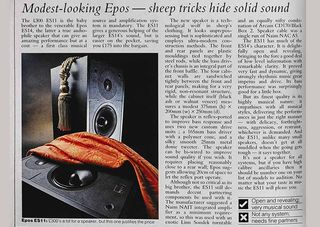
We enter the 90s with Epos' ES11s, which were similar in sonic character to the legendary ES14s but available for a fraction of the price.
As was usual for the brand, the crossover was minimal - it employed a single capacitor for the tweeter. That helped the ES11 produce surprisingly sturdy bass and excellent resolution, as well as superb rhythmic drive and dynamic expression.
A really musical pair of speakers, they could deliver just the right amount of aggression, delicacy or restraint a song demanded.
MORE: Epos K2 review
Monitor Audio Studio 20 (1992)
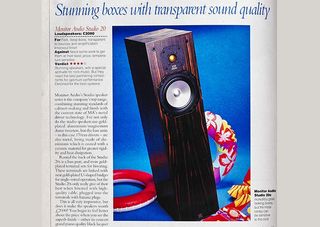
£2000 was a lot for a speaker back in 1992 (it still is), but the Monitor Audio Studio 20s weren't your run-of-the-mill floorstanders.
With metal drivers on board, they delivered fast, deep bass, punchy overall sound and sweet treble. This made the Studio 20 one of the most detailed-sounding speakers we'd encountered.
They needed some fine-tuning and a fair bit of running in thanks to those metal drivers but, these issues aside, they were incredibly well finished and terrific-sounding speakers.
MORE: Monitor Audio Silver 100 review
Mission 753 (1992)
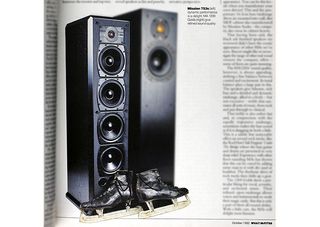
The 753s were stylish floorstanders that produced a dynamic performance.
They had a smörgåsboard of drive units with four 13cm drivers – two mid/bass drivers, two low bass units – and a single 25cm dome tweeter packed into the 753's slim cabinet.
The Missions didn't do laid-back, offering a fast and punchy listen that had a real sense of vitality for those willing to take the time to run them in properly.
They were an all-round delight for anyone who enjoyed an involving and exciting sound.
Tannoy Mercury M2 (1997)
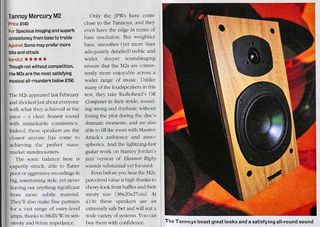
The Mercury M2s entered the market in the late 90s and made an immediate impression.
Our ears hadn't heard a more satisfyingly musical all-rounder at this price level. The larger-than-average M2s generated a performance that struck an expert sonic balance, with consistently superb bass and treble performance.
Back then, we felt they were the closest anyone had come to creating the perfect mass-market standmounter.
MORE: Tannoy Eclipse Three review
Dynaudio Contour 1.1 (1999)

The Contour 1.1s were medium-sized standmounters that proved size was no barrier to delivering solid bass.
The quantity of bass didn't affect detail or insight, as the Contours benefitted from a great sense of timing. And their with high-frequency delivery found the right balance between sweetness and attack.
If you liked music to be delivered with a punch, the Contour 1.1s dynamic performance, excellent timing and satisfying bass made them a terrific buy.
MORE: Dynaudio Special Forty review
Wilson Benesch A.C.T. One (1999)
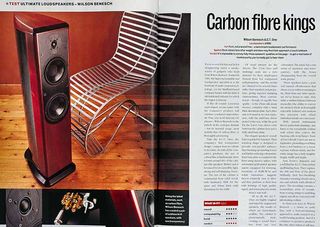
Wilson Benesch made a big splash with its first loudspeaker, the A.C.T. One.
Made mostly of carbon fibre, solid wood and laminated MDF, they were superbly engineered and elegant-looking units.
More than any speaker we'd heard up to then, they struck a sublime balance between musicality and analysis.
MORE: Wilson Benesch A.C.T review
B&W DM602 S3 (2002)

B&W's DM602 S3s were big standmounters that produced an even bigger sound.
They had the latest technology for the time: the two-way loudspeaker featured 25mm aluminium metal dome tweeters and Kevlar mid/bass units. But they needed breathing space to perform at their best.
Granted that room, the speaker's dynamic presentation, precision and agility at the low end made them a talented proposition.
MORE: That Was Then… B&W 602 S3 review
Mission 780 (2002)

By 2002, Mission's 780 standmounters had bagged two Product of the Year awards.
They had clever technical features, including a tweeter isolation system, a ceramic mid-bass driver and a cabinet construction that aided structural rigidity.
The bass was tight and powerful, the midrange impressively insightful and the tonal balanced even. The 780s weren't fazed by whatever music you threw at them.
See all our Mission reviews
Quad 11L (2004)

The Quad 11Ls had a rock-solid build and excellent finish, but the sound was what really grabbed our attention.
In terms of transparency, detail resolution, speed and dynamics, rivals really struggled to match them.
If you wanted the best sound and build quality at a reasonably affordable price, the 11Ls offered astonishingly good value at the time.
MORE: Quad 11L Classic review
ATC SCM 11 (2006)

The ATCs were the type of speaker that could play any type of music with ease.
The Gloucestershire-based company opted for a sealed cabinet for agile bass performance. The speaker's two-way design had a mid/bass driver that was developed in-house and featured a hefty motor system.
As performers, they were talented in various hi-fi disciplines - either class-leading or not far off it in terms of timing, dynamics and scale.
They lost a little performance at low volume and were not sensitive - so they needed a hefty amplifier - but these were quibbles. They would only get better with the 2013 iteration.
MORE: ATC SCM 11 review
Quad ELS 2805 (2008)
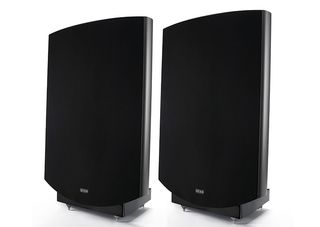
Quad showed no sign of resting on its laurels with the ESL 2805, the latest in a range of legendary electrostatic speakers that stretched back to the 1950s.
Care was needed setting up, as they fire equal amounts of sound backwards and forwards. Once done, the speaker's natural midrange, excellent detail resolution and cohesive sound came to the fore.
The lack of punch and slightly lumpy bass were drawbacks, but in other ways they were truly exceptional.
MORE: Quad ESL-2805 review
Wilson Audio Duette (2008)

Wilson Audio's £11,000 'entry-level' Duettes made you question whether the company understood the term.
Designed to be unfussy when it came to placement, these large two-way standmounters had a great sense of detail, timing, resolution and insight.
The soundstage the Duette produced was huge and the bass well-articulated, and the adjustable crossover allowed for a wide range of positions (including horizontally).
One of the best pairs of speakers we've had the pleasure of listening to, offering surprisingly good value even at that huge price tag.
MORE: Wilson Audio Duette review
Eclipse TD 712z Mk2 (2009)

The TD 712z Mk2 encapsulated Eclipse’s approach to stereo speaker design with its single driver unit and sophisticated cabinet.
Intended to properly reproduce an impulse signal (a sharp, short sound), the Mk2 achieved this with aplomb. Timing was brilliant, as were dynamics, and they sounded more coherent than just about anything else at the time - regardless of price.
They weren't as adept with the frequency extremes because of that single driver, but we could forgive their limitations. It was a different approach to speaker design that yielded a wildly entertaining sound.
MORE: Eclipse TD 712z Mk2 review
Totem Mani-2 Signature (2010)

Glance in the direction of the Totems and they look a bit ordinary.
In production for two decades, the Mani-2s had stupendous bass power and authority thanks to isobaric bass loading.
The overall sound was cohesive and the sonic balance highly musical. Despite their compact stature, they could offer huge scale too.
In terms of outright enjoyment, few, if any, were better at the price.
MORE: Totem Mani-2 Signature review
ATC SCM 100A (2011)

The SCM 100As were imposing and functional lookers, but capable of great sound.
Rarely had we heard bass sound as good, as loud or as nuanced. Tonally they were spot-on, and capable of being immensely muscular as well as delivering a dose of subtlety too.
The ATC's range of abilities meant they were handy across a wide range of music. Just be careful moving them: each speaker weighed a backbreaking 68kg.
MORE: ATC SCM 100A review
B&W 800 Diamond (2012)

B&W's 800 Diamond speakers were packed to the rafters with cutting-edge technology.
They were the ultimate expression of B&W's approach to sound. From tweeter domes made out of diamond, to cleverly braced and shaped cabinets, to cones made out of Kevlar, they were innovative speakers.
The bass was stunning, as was detail and dynamic reach. All of this sound was delivered with speed and punch. Quite possibly one of the best speakers ever made.
MORE: B&W 800 Diamond review
KEF LS50 (2012)

The KEF LS50s were, and remain, blindingly good speakers.
A lot of thought went into the cabinet, from the curved front panel to the materials used in the speaker's construction.
That craftsmanship was felt in the performance – thanks in no small part to KEF's innovative UNI-Q driver – which produced an insightful and musical sound.
The LS50s were a fun speaker and formed the basis of the spellbinding LS50 Wireless system.
MORE: KEF LS50 review
Neat Iota (2012)
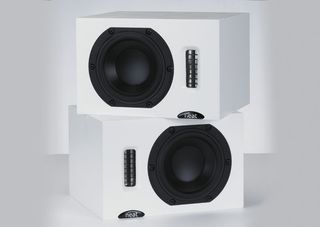
The Teesside-based loudspeaker company employed an unusual design for its compact speaker. They're designed to be used on their sides, not standing up, and they emit a hefty sound that's got plenty of detail, weight and scale for their size.
The tiny Iotas are unfussy about positioning - overall, the Neats are odd, but brilliantly so. A speaker unlike so many on this list.
MORE: Neat Iota review
Focal Diablo Utopia (2012)

Focal's Diablos made a convincing case for spending £8000 on a standmounter.
The tweeter domes were fashioned out of the rigid substance Beryllium and the mid/bass motor system had a clever magnet arrangement, one that optimised magnetic power and minimised any losses.
All that technical wizardry generated a performance of exceptional detail, agile bass and seamless integration of voices and instruments.
They cost a fortune, but you got what you paid for.
MORE: Focal Diablo Utopia review
ProAc Response D40R (2013)

ProAc's Response D40R were tall speakers that needed a large room to make the most of their potential.
Give them breathing space and you had a musical speaker that was as articulate, transparent and dynamic a floorstander as we had heard at the price.
This was a speaker that was good at getting out the way and letting the music take centre stage.
MORE: ProAc Response D40R review
Q Acoustics Concept 20 (2013)
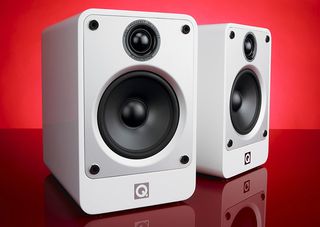
The strength of the competition at their price is fierce, but it speaks to the talents of Q Acoustics' Concept 20s talents they remain a favourite.
They use a complex cabinet design, with two layers of MDF separated by a lossy Gelcore material that reduces cabinet resonances. The Concept 20s deliver a satisfying sense of punch and attack, while also producing an articulate and subtle presentation.
They are good at most things, making them a fine choice for all types of music. For standmounters (comfortably) under £500, they're still right up there.
MORE: Q Acoustic Concept 20 review
PMC Twenty 26 (2014)

We've come to expect excellence from PMC's Twenty range and the Twenty 26 are no exception.
Though there are more revealing high-end floorstanders available – mostly at higher prices – few are as musical or as balanced as the Twenty 26.
With strong dynamics, impressive detail and an unfussy, musical nature – it is hard to fault the 26s in any one particular area.
MORE: PMC Twenty 26 review
Spendor SP2/3R2 (2016)
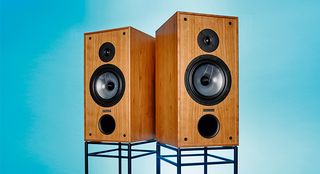
It'd be easy to dismiss Spendor's SP2/3R2 as some kitsch, retro throwback, but that would be to miss out on an easy-going loudspeaker.
Some rivals produced a more exciting listen, but this large standmounter delivered a huge sonic stage with class-leading scale and authority.
They didn't grab your attention with sonic fireworks, but with relaxed, insightful sound.
MORE: Spendor SP2/3R2 review
Spendor A4 (2017)

We noted recent Spendor speakers tended to prioritise analysis over entertainment.
But not so the A4, which is capable of both. With a presentation that is articulate and expressive, they have plenty of detail, insight and a lovely midrange.
Put them away from a rear wall and these unfussy, compact floorstanders are splendid company.
MORE: Spendor A4 review
JBL K2 S9900 (2017)

The K2s are fabulous, retro-styled speakers. Oddly proportioned – wider than they are deep – and weighing 83kg each, these speakers are not to be trifled with.
The horn-loaded tweeter and midrange units help their performance in larger rooms, offering exceptional resolution and great insight.
If you have a big enough bank balance, these JBLs are among the best speakers money can buy.
MORE: JBL K2 S9900 review
